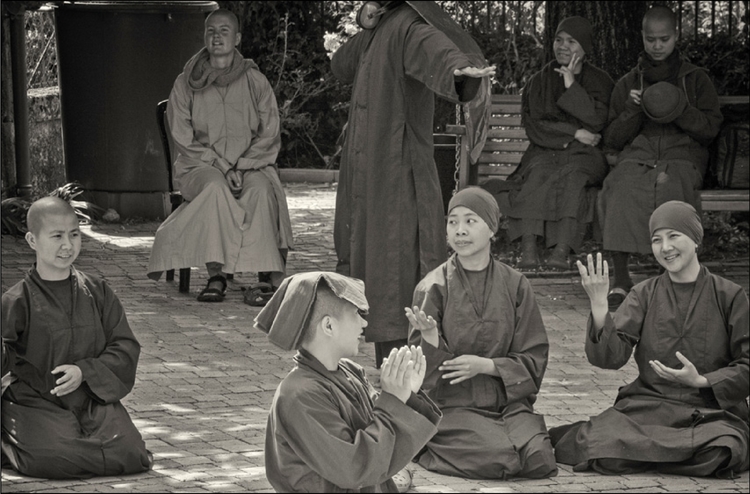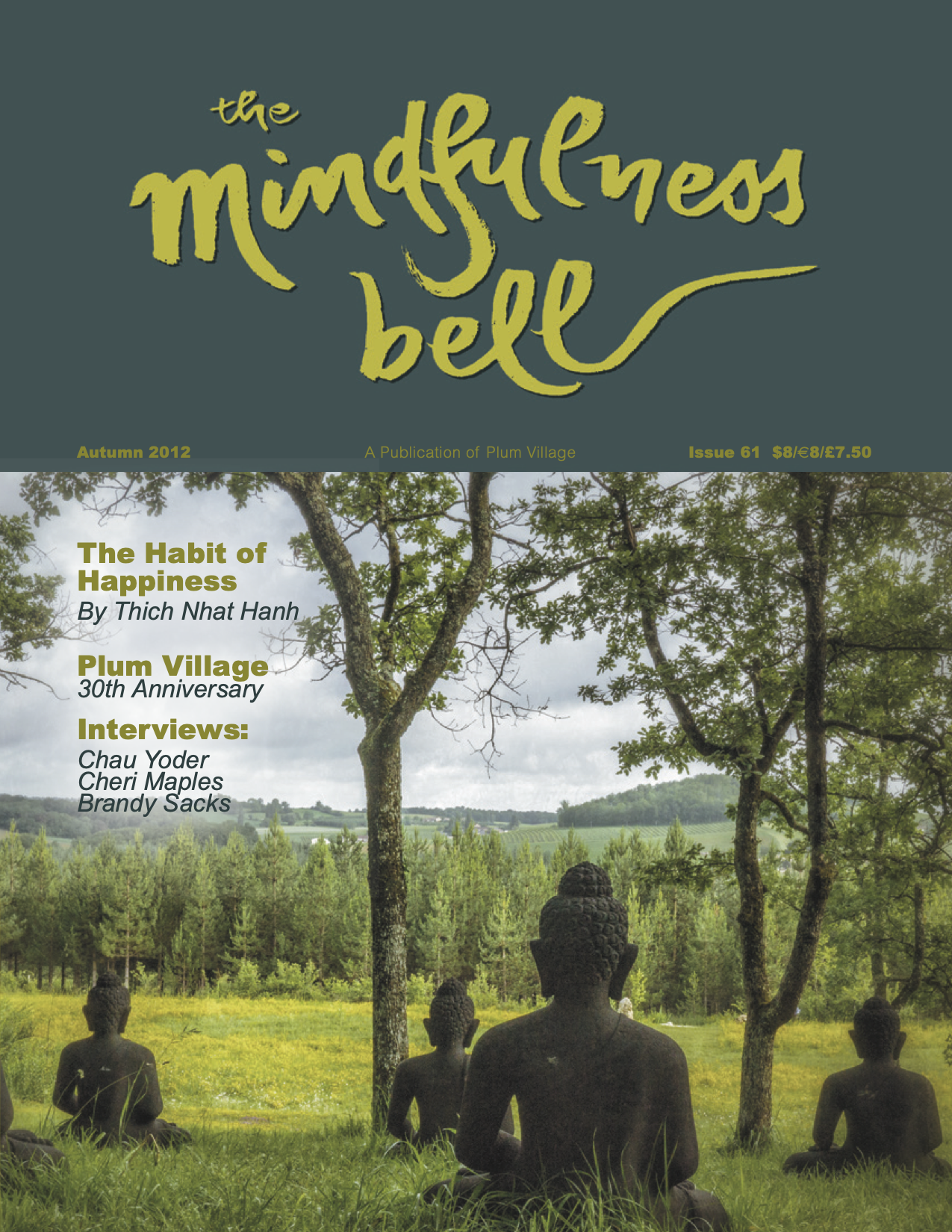By Tetsunori Koizumi

Interbeing as a Binary Relation
“Interbeing” is a new word invented by Thich Nhat Hanh (Thay), which he employs to explain the interconnectedness of all things in the universe. A sheet of paper, for example, is an interbeing as it is connected with a cloud through a chain of relationships. “Without a cloud, there will be no rain; without rain, the trees cannot grow;
By Tetsunori Koizumi

Interbeing as a Binary Relation
“Interbeing” is a new word invented by Thich Nhat Hanh (Thay), which he employs to explain the interconnectedness of all things in the universe. A sheet of paper, for example, is an interbeing as it is connected with a cloud through a chain of relationships. “Without a cloud, there will be no rain; without rain, the trees cannot grow; and without trees, we cannot make paper,” Thay writes in The Heart of Understanding: Commentaries on the Prajnaparamita Heart Sutra. Things that appear totally unconnected to most people—a sheet of paper and a cloud, in this example—become connected with each other in a relationship which Thay calls “inter-are.”
Technically speaking, interbeing can be regarded as what mathematicians call a “binary relation,” a relationship established on a set of elements by pair-wise comparison of them, defined in this case on the set of all things in the universe, including our consciousness. It is not difficult to see that the binary relation of interbeing satisfies the three laws of reflexivity, commutativity, and transitivity. First of all, it is obvious that anything inter-is with itself, albeit in a trivial sense of that word. Thus, the binary relation of interbeing satisfies the law of reflexivity, namely, xRx, where the symbol R designates the binary relation of interbeing.
The binary relation of interbeing also satisfies the law of commutativity, namely, xRy implies yRx, for if one thing inter-is with some other thing, then the second thing inter-is with the first. By bringing three things into consideration now and examining the applicability of interbeing among the three pairs of two things that result from them, we can see that the binary relation of interbeing further satisfies the law of transitivity; namely, xRy and yRz imply xRz. In the above example, a cloud inter-is with rain and rain inter-is with trees, implying that a cloud inter-is with trees.
Given that the binary relation of interbeing satisfies the three laws of reflexivity, commutativity, and transitivity, it becomes a matter of logical exercise, aided by a modicum of poetic insight, to establish the interconnectedness of all things in the universe. Thus, roses and garbage inter-are, another favorite example used by Thay to illustrate the concept of interbeing. We can also appeal to P. B. Shelley (1792-1822) who employs poetic insight to express the same binary relation of interbeing in a poem entitled “Music:”
Rose leaves, when the rose is dead,
Are heaped for the beloved’s bed.
And that beloved’s bed, as we know, is the soil from which a new rose tree grows with a new set of rose leaves and flowers!
This Is Because That Is
The genius of Thay as a teacher of Buddhist thought becomes quite evident when he skillfully employs the concept of interbeing to explain the idea of sunyata, or emptiness, which is probably the most profound teaching of the Buddha on the nature of reality in the world around us. In terms of the binary relation of interbeing introduced above, the Buddha’s words as recorded in Samyukta Agama—“the Middle Way says that this is, because that is; this is not, because that is not”—can be expressed as follows: that x exists in M, or the manifest world, implies that there exists y, different from x, such that xRy; x does not exist in M if there does not exist y, different from x, such that xRy.
By applying this binary relation of interbeing repeatedly to all the other elements that connect a sheet of paper to a cloud, we derive another of Thay’s favorite expressions: “A sheet of paper is made of non-paper elements.” This can be expressed as: xR(~x), where x stands for a sheet of paper, and (~x) for non-paper elements. A natural conclusion that follows from this logical exercise is that a sheet of paper—indeed any thing, for that matter—does not exist as a separate and independent entity, and is therefore inherently empty.
The term interbeing, although it appears to designate something that lies in between being and nonbeing, is actually a word Thay invented to expound the Buddhist idea of the Middle Way. We must go beyond the concepts of both being and nonbeing if we are to understand the idea of emptiness. As he puts it in Beyond the Self: Teachings on the Middle Way: “The Middle Way goes beyond ideas of being and nonbeing, birth and death, one and many, coming and going, same and different.”
By going beyond our dualistic way of seeing things (either “something exists” or “something does not exist”), we are able to develop the right view to see things, not in the lokadhatu, or the manifest world where things appear to be born and to die and to exist independently of one another, but in the dharmadhatu, or the ultimate realm of things as they are. As we learn to see things as they are, it will become clear to us that there is neither being nor nonbeing, neither birth nor death.
A Child’s Wisdom
Let us now go back in time—as time is conceived in classical physics—to 1798 when Wordsworth (1770-1850) wrote a delightful poem titled “We Are Seven.” In this poem, Wordsworth writes about his encounter with an eight-year-old cottage girl:
A simple child,
That lightly draws its breath,
And feels its life in every limb,
What should it know of death?
Asked by the poet how many sisters and brothers she has, this little girl answers:
“Seven boys and girls are we;
Two of us in the church-yard lie,
Beneath the church-yard tree.”
The answer confounds the poet because two of the seven brothers and sisters are already dead and buried in the churchyard. To the poet who reminds her that only five boys and girls are left if two are buried in the churchyard, the little girl answers emphatically, “O Master! We are seven.” As far as this little cottage girl is concerned, two of the seven brothers and sisters who are buried beneath the churchyard tree are not dead, as she daily plays with them in the churchyard.
Can we reject this little cottage girl’s answer as a reflection of her ignorance and concur with Wordsworth that she knows nothing of death? What is more intriguing for us is to speculate how Wordsworth would have responded had she answered, “O Master! We are seven—seven interbeings.” The poet, to be sure, would have been even more confounded by this answer. On the other hand, we can easily imagine how Thay would nod approvingly with a smile on his face. It was this cottage girl with her innocence of a simple child, not the poet with his knowledge of a mature adult, who was able to see things as they are.
Tetsunori Koizumi, a member of Blue Heron Sangha, is Director of the International Institute for Integrative Studies in Columbus, Ohio. This article was inspired by Thich Nhat Hanh’s Dharma talks during the “Science of the Buddha” retreat in Plum Village in June 2012.

